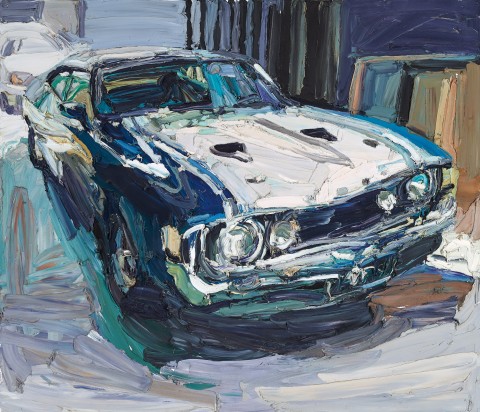PAUL’S FALCON, 2008
BEN QUILTY
oil on linen
183.0 x 214.0 cm
signed and inscribed verso: XA Ben Quilty
signed, dated and inscribed verso: XA / 2008 / Ben Quilty
GRANTPIRRIE, Sydney
Private collection, Sydney
Slade, L. (ed.), Ben Quilty, University of Queensland Art Museum, Brisbane, 2009, pp. 12 – 13 (illus. in studio with artist)
‘As the car came to life, he settled back in his seat. And instantly, all the niggling problems he knew he’d have to deal with seemed totally unimportant’ – General Motors Holden advertisement, The National Times Colour Magazine, 1 October 1982
Ben Quilty’s car paintings constituted his breakthrough moment in the Sydney art scene, emerging from a personal experience of growing up in the suburban outskirts of Sydney, where there was little else to do than hoon around the streets in an elaborate and foolish display of youthful bravado and testosterone. The old maxim of ’paint what you know’ has served Quilty well, and sustained a vast series of candy-coloured and lusciously thick paintings of iconic Australian cars, culminating with this painting of the powerfully masculine muscle car, the Ford Falcon XA (GT) coupe. This one here belongs to Paul, the artist’s friend and fellow rev-head.
As Lisa Slade noted in 2009, ’Cars are, of course, a type of currency – not only do they reflect the identity of their owners, but they also provide a means of bartering, and sometimes altering that identity.’1 Borne of a friendship with the car’s owner, this painting was first imagined as a swap, before the artist found his own, metallic blue XB model. Displayed front-on and posing for the camera in a double-portrait, dominating the little Subaru behind it, owned by Paul’s partner, Jenny, Paul’s Falcon hums with pride. Personified to a point, on the cusp of springing into an anthropomorphised machine, the car is both a portrait and a landscape, describing the strong link between the car and the freedom it lends to the owner to exist within and roam the vast Australian land. Considering Australia rates 4th in the world for car ownership per capita, the visual symbol of a second-hand statement car is both ubiquitous and a relatable prism through which Australians have experienced and acted upon the landscape.
The Ford Falcon was known for its distinctive coke bottle shape (a narrow centre surrounded by flaring fenders), lightweight and packed with a powerful V8 engine. The Falcon’s aggressive design evoked a swift, strong and menacing presence that appealed to young men. Quilty’s signature trowelled application of paint mirrors this emphatic presence, the peaks of paint jutting towards the viewer, extending in paint the forward surge of the car’s own exaggerated forms. Sculpted in harmonious bruise-like tones of black, lilac, slate and ecru with highlights of turquoise, green and pale ochre, the lines follow the bold forms of the car’s drag-racing silhouette. This effect is further reinforced by the expansive gestures of wide brushstrokes in the areas surrounding the car, orthogonal above the car and almost scribbled below, supporting and highlighting the inherent dynamism of the vehicle, poised to roar into action. The paint is frozen in a testament to Quilty’s vigorous fervour and enjoyment of the act of painting, so long as his formal enthusiasm remains subordinate to figuration and realist aesthetics.
Resonating with national significance, this muscle car was released in the peak years of Australian automotive optimism. Locally manufactured and affordably maintained, the high-performance muscle cars of the 1970s were made famous as a feature within George Miller’s trilogy of Mad Max films and today have become highly-prized collector’s items. Although Quilty often painted these empty cars with doors and bonnets flung open to proudly display their impressive internal mechanics, Paul’s Falcon isn’t peacocking. Quietly parked, its power still emanates through the thick layers of paint, conferring heady confidence-building fumes of what Lisa Slade jokingly called the ’white yobbo dreaming’.2
1. Slade, L., ‘Ben Quilty – We are History’, Ben Quilty Live!, University of Queensland, Brisbane, 2009, p. 22
2. ibid., p. 14
LUCIE REEVES-SMITH
